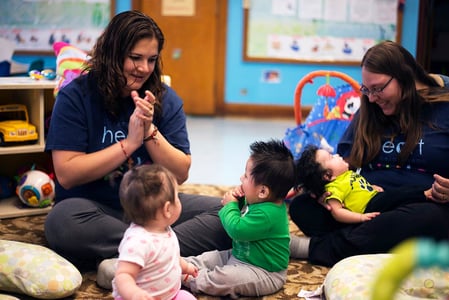
Young infants develop a unique relationship—known as attachment—with their caregivers. To develop secure bonds, infants need to know that at least one person really cares about them. Caregivers provide that comfort by helping infants regulate needs and emotions, such as hunger and sadness. With healthy attachments, infants develop a sense of safety and trust.
Infants need to be held, to have face-to-face interactions, to feel another human heartbeat. By meeting these needs, caregivers foster attachment. Plan how you will meet these essential needs—while keeping yourself and infants safe.
How to Maximize Attachment in a Socially Distanced Setting
Building Attachment
Caregivers need to build attachment with infants to help them thrive. Meanwhile, social distancing is necessary to keep settings safe. Healthy attachments are a strong starting place for infants to learn and grow.
- Respond to infants’ specific needs, washing your hands before and after any touch.
- Wear face protection when you’re holding infants close.
- Follow through if infants cue that they’d like to explore, and disinfect surfaces after.
Forming Emotional Trust
When infants can trust their caregivers, they feel not only safe but also ready for learning and developing. Some social distancing precautions mean caregivers need to make an extra effort to form that trust.
- Use your eyes and voice to match infants’ affect when you’re wearing a mask.
- Be consistent in your responses to infants’ needs.
- Celebrate infants’ efforts with an excited voice and gesture.
Providing Resources
When frightened, sad, frustrated, or even disgusted, infants seek comfort in caregivers. Different emotions call for different responses. But in socially distanced settings, staying safe is always a part of providing reassurance.
- If you can’t physically meet an infant’s need right away, gently call out their name.
- When your mask upsets an infant, use it to play peekaboo. Wash your hands afterward.
- Continue providing care after providing reassurance.
Now that you’ve read some ways to form attachment in your socially distanced setting, use this planning document to brainstorm how you will form attachment with the infants in your socially distanced classroom.
Family members are a child’s first teachers. So caregivers should maintain a close partnership with families. Building a trusting relationship with them helps you take all necessary precautions to keep infants and yourself healthy. Whether by phone, email, or text, provide opportunities for each family to share information and ideas about the developmental goals for their child. You can also schedule opportunities to share developmentally appropriate practices at home. Finally, by sharing videos of your interactions with infants, families can hear you demonstrating those practices, responding to their needs, and building healthy attachment.


